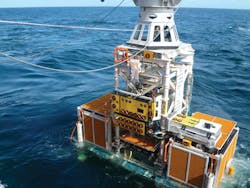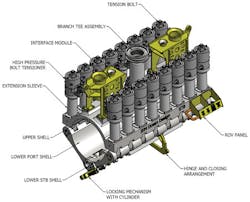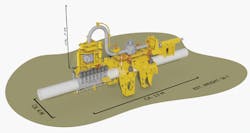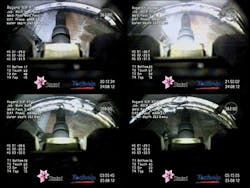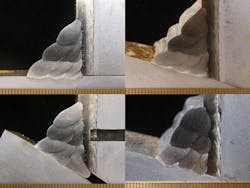Retrofit tee offers hot tap option
Neil Woodward
Isotek Oil & Gas Ltd.
Jørund Fonneland
PRS Technip-DeepOcean JV
Bjørn Bakkevig
Statoil ASA
The capability for remote hot tapping using a retrofit tee represents a tremendous opportunity to enhance and make the most out of the existingoffshore pipeline network. This applies particularly to new development projects that are looking to tie in to existing pipeline systems.
In 2012, remote hot tapping was successfully employed on the Åsgard B production flowline as part of theÅsgard Subsea Compression Project (ÅSCP) at 265 msw (meters/sea water), beyond diver-depths in the North Sea. It is estimated that the improved recovery from the Midgard and Mikkel reservoirs will result in an equivalent of 306 MMbbl after the complete Åsgard subsea compression solution went live in 2015.
Developed by Statoil, this new hot tap technology has now been selected for two major future subsea operations: remotely hot tapping the Zeepipe 2A pipeline in 2017, and the Statpipe transport pipeline as part of the Johan Sverdrup project in 2018. The Gina Krog reservoir requires gas-injection, and will import gas from the Zeepipe 2A 40-in. pipeline. The Johan Sverdrup gas field development will export gas via a new 18-in. pipeline, tied into the Statpipe rich-gas leg by means of hot tapping and connection to a 30-in. retrofit tee.
Hot tapping
A hot tap is the process of breaking into a live pipeline while the product is flowing, without interrupting the production, to provide a pipeline branch for the possible flow diversion in either direction. The remote hot tap involves the deployment of a retrofit tee and cutting the membrane of the mother pipe through a valve placed on the branch of the tee, extracting the membrane and cutter, and then closing the valve until an external connection is made to facilitate the diversion.
While some tees are pre-installed when the pipeline is laid, the retrofit tee may be implemented at any chosen location. This is especially beneficial for mature fields where the existing pipeline infrastructure has excess transportation capacity due to the gradual decay in production. When a field is in its tail end of production, pipeline operators will consider cost-saving ways to produce at lower pressures, or to develop new marginal reserves in the same region.
By using the remote hot tap technology, the operator may tie-in a compression facility or a new single well to the existing infrastructure without the costly investment of a new pipeline system. The method may also be used for converting oil-producing fields to gas production; introducing gas lift into oilfields; and bypassing in the event of pipeline damage. This technology is a highly important tool for operators: it gives them the ability to connect anywhere on a pipeline, without halting production, thereby yielding considerable flexibility and significant savings.
The technology won an OTC Spotlight on New Technology Award for the Remotely Welded Retrofit Subsea Hot Tap Tee at the OTC Conference in 2013. The equipment has been subjected to an extensive technology qualification program with third-party approval by DNV GL.
Development and operation
For the retrofit tee and all associated equipment, there was a three-year development program that involved prototyping, equipment acceptance trials, robustness testing, and shallow-water trials. This effort culminated in deepwater trials that were a rehearsal for the first offshore use in 2012. The process incorporated consultation with Statoil and DNV GL, who reviewed the acceptance criteria and conclusions. The qualification process was verified and certified by DNV GL, who issued a final certificate of fitness for service and a product certificate for the fabricated retrofit tee.
The offshore remote hot tapping operation involves: as-found site survey and site preparation, including concrete removal and removal of the seam weld; installation of the retrofit tee, tensioning the tee on the live mother pipe using the tee installation tool; remote welding of the tee to the mother pipe after landing the welding tool on the tee using guide posts and establishing the acceptable welding environment; installation of the hot tap ball valve; installation of the hot tap cutting machine; and performing a pressure test of the entire assembly prior to performing the remote hot tap cut itself.
After the hot tap, the cutting head, together with the cut-out pipe segment, is withdrawn through the ball valve and the ball valve closed to isolate the retrofit tee and pipeline product. The hot tap cutting machine is then recovered. Finally, the installation of the gooseneck spool with valve and protection structure is deployed to complete the subsea operation.
The retrofit tee, deployed in 2012 as part of the Åsgard subsea compression project, was for a 20-in. mother pipe, whereas next year’s Zeepipe 2A Retrofit Tee is twice the size for a 40-in. mother pipe. The new Zeepipe 2A 40-in. Retrofit Tee design, by IKM Ocean Design AS, can be seen in the associated piece of art.
The retrofit tee combines the use of a remotely installed mechanical clamp, providing the structural integrity and interface with the isolation valve module and the hot-tap cutting tool, and a “seal weld” made by remotely operated hyperbaric metal inert gas (MIG) welding inside the branch pipe. The intention of the seal weld is not to provide structural capacity as such, but to make a highly reliable seal (“metal-to-metal”) to at least the same quality standard as traditional manually welded hot-taps.
Qualification of the technology has taken place over a number of years, with the hot tap cutter developed first and deployed on a diver-installed tee in 2008 at 145 msw as part of the Tampen Link project, and then on two pre-installed tees in 2009 at some 860 msw, as part of the Ormen Lange southern field development program.
Diverless welding
A key enabling technology for the remote hot tapping solution is the ability to perform a dry hyperbaric weld in-situ without the use of divers. The dry hyperbaric offshore operation is simulated in the laboratory by welding at elevated pressure in an inert environment using the offshore weld control systems and welding equipment. Dry hyperbaric MIG welding in the laboratory has been operated at up to 4,000 msw (400 bar). Fundamental welding research, development and hyperbaric weld procedure qualification have been performed over many years in the laboratory to the third-party acceptance of DNV GL. The remote hot tap welding tool was developed and subjected to two separate deepwater tests in 2011 and 2012, validating offshore test welds against the laboratory welds, prior to the key milestone of the world’s first remote production weld for the ÅSCP. After initial testing in 2011, the design of the pre-heating induction coils of the welding head was modified in order to provide a more homogeneous heating distribution in the welding zone. A second observation camera was also added to aid welding torch path programming and close visual inspection.
Background work with the hyperbaric MIG welding process has also focused upon the repair of subsea pipelines using steel consumables.
In contrast, the remote hot tap application adopted the selection of corrosion resistant alloy consumables (Inconel 625 and Alloy 59) for the application requirements. Constriction of the hyperbaric welding arc at pressure forces the MIG welding process into a more frequent short-circuiting mode, which greatly enhances the penetration and fusion into the parent materials. Specially developed welding power sources and a welding power source control strategy operating at 10kHz is required for stable process operation. Weld procedure development work comprised two distinct phases: a pre-qualification phase, addressing particular areas of concern; followed by a qualification phase, establishing the behavior of the derived welding parameter set with worst case environmental parameters. Weld Procedure Qualification work was performed in accordance with the requirements of the offshore standard DNV-OS-F101 (Submarine Pipeline Systems) with additional work addressing the recommendations from DNV-RP-F113 (Subsea Pipeline Repair), testing the robustness of the procedure and establishing the acceptable tolerance limits.
Through initial trials in the laboratory and deepwater testing offshore, it has been proven that the remote welding equipment may be recovered and re-deployed within 30 days with acceptable results, in case the welding operation is interrupted due to bad weather, for example. Topsides visual inspections looking down on the completed welding passes 1, 3, 5, and 6 from the offshore Åsgard operation are shown in the “offshore visual inspection” image.
For the ÅSCP application extensive research, development and qualification work was performed over several years in a hyperbaric welding facility in the United Kingdom. Alloy 59 (Ni, Cr, Mo) was selected as the best welding consumable, established with consistently good weld quality, acceptable mechanical properties, excellent corrosion resistance and resistance to solidification and hydrogen assisted cracking. The successful deepwater tests prior to the production weld validated the work performed in the laboratory.
The comparatively slow welding travel speed used for the remote hot tap application seal weld procedure generated highly acceptable weld quality (from multiple macro-examinations) and favorable mechanical properties in terms of HV10 Hardness, All-Weld Tensile, Charpy V Notch and Fracture Toughness. The slow welding travel speed was also highly beneficial with regard to minimizing the risk of solidification cracking in the presence of a large root gap. Alloy 59 has also been found to be highly resistant to Hydrogen Assisted Cracking (HAC) also known as Hydrogen Induced Cold Cracking (HICC), a potential risk for pipeline steels when welding in cold and/or potentially humid environments.
Extensive pre-qualification and qualification work of the robust weld procedure was performed in the laboratory at the worst case high humidity (>24°C dew-point) and low temperature (4°C) enabling offshore use either with or without the use of pre-heat. Offshore, the welding environment is comparatively dry after inert Argon gas flushing and a low level of pre-heating is applied although it is not formally required.
A new 400-bar hyperbaric welding facility has now been commissioned in Killingøy, just outside Haugesund, Norway, the base of the pipeline repair system. The large pressure vessel facility allows the completion of the full six-pass saddle weld inside the pressure chamber and enables the training and qualification of the welding operators in-situ, in conjunction with the hyperbaric weld procedure qualification work. In early 2016, the ÅSCP weld procedure (265 msw) was validated in Killingøy for use on the less conservative Zeepipe 2A (80 msw) and Johan Sverdrup (110 msw) applications: both these applications are in shallower water and on larger pipeline diameters of the same API 5L X65 material grade.
While the welds produced in the laboratory are subject to visual, non-destructive examination (NDE) and mechanical property testing, the offshore fillet welds are validated by visual examination and a well-established and tested quality assurance monitoring strategy. The monitoring strategy has been qualified in the laboratory and thoroughly tested offshore, and adheres to the requirements stipulated in DNV RP-F113. The critical welding variables are monitored every second subsea: arc voltage, welding current, wire-feed speed and travel speed. The arc voltage and welding current signals are sampled at a higher frequency of 1kHz subsea and averaged for close monitoring on the surface by the welding operator and engineer. For every second of the weld, compliance of each critical welding variable with the established target levels in the hyperbaric weld procedure specification is crucial for acceptance in conjunction with the visual inspection after each pass. For the six-pass remote hot tap weld, this represents approximately 1,300 seconds of welding for the retrofit tee weld inside the 12-in. branch insert.
References
Apeland, K.E., Verley, R., Berge, J.O., Woodward. N, Armstrong, M. and Lindøe, O.E., 2013, Remote Welded Retrofit Hot-tap Tee: a New Era for Hot-tap Connections to Offshore Pipelines?, OPT 2013, 6-9th May Houston, Texas, USA
Woodward, N., Apeland, K.E., Berge, J.O., Verley, R., and Armstrong, M., 2013, Subsea Pipelines: The Remotely Welded Retrofit Tee for Hot Tap Applications, OMAE2013, June 9-14, 2013, Nantes, France

